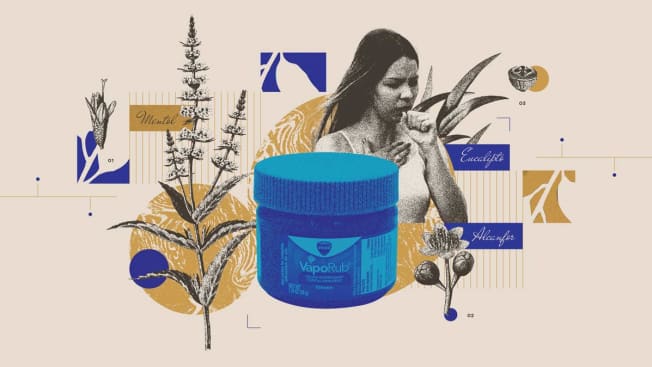Many People Swear by Vicks VapoRub. Is the Love Justified?
The use of the salve among Hispanic families for respiratory illnesses and pain runs deep. Here’s how this age-old product works.
When you shop through retailer links on our site, we may earn affiliate commissions. 100% of the fees we collect are used to support our nonprofit mission. Learn more.

When Liliana Mendoza was a kid growing up in Mexico, Vicks VapoRub was a go-to treatment in her household for common colds and pain.
“My grandma used to use it on our chest, our back, and our nose. And my mom used to put it on the bottom of my feet when I used to complain about what I know now are called growing pains,” says Mendoza, a mom of three who now lives in Austin, Texas.

Photo: Courtesy of Liliana Mendoza Photo: Courtesy of Liliana Mendoza
And the smell of VapoRub, like the smell and steam from chicken soup, may remind people of the attention and care they received when ill. That care itself can be healing, says Christopher Fagundes, PhD, an associate professor at Rice University in Houston who focuses on psychoneuroimmunology, or the effect of the mind on the immune system.
Here’s what you need to know about VapoRub, including why just the smell of it seems so healing to so many people.
What’s in VapoRub?
According to Vicks manufacturer, Procter & Gamble, VapoRub’s active ingredients are menthol and camphor, both of which are cough suppressants and topical pain relievers, as well as eucalyptus oil, which is a cough suppressant.
The ingredients work in similar ways, says Neil Bhattacharyya, MD, a professor of otolaryngology at the Harvard Medical School and surgeon at Massachusetts Eye and Ear hospital in Boston.
“These are, in a sense, essential oils that provide a cooling effect that masks the feelings of congestion and pain,” he says.
Bhattacharyya compares that effect with rubbing your knee if you’ve accidentally hit it. “You kind of overwhelm the brain receptors for pain by giving the counterstimulation of rubbing the knee that you just bonked on the desk,” he says.
VapoRub for Congestion
The cooling effect from VapoRub explains how its active ingredients ease the feeling of congestion, Bhattacharyya says. They “can help by creating the sensation that more air is flowing into your body when you breathe,” he says, adding that this is also how some cough drops, such as Halls, work.
“It gives you the sense of your throat being cooled off,” Bhattacharyya says. “Just like in Bengay, by the way, or Tiger Balm, the counterstimulation substitutes for the soreness of a sore throat or the feeling of congestion, and it tricks your brain.”
So while products such as VapoRub can serve as a distraction from congestion and cough, they won’t change the course of the underlying illness on its own, he says.
Vicks VapoRub is for external use only, stresses Mollie Wheeler, a spokesperson for Procter & Gamble. As a cough suppressant for minor throat and bronchial irritation associated with the common cold, rub a thick layer on your chest and throat and cover them with a warm, dry cloth, she says. To let the vapors reach your nose and mouth, keep your clothing loose around those areas, she says. According to the label on the jar, VapoRub should never be ingested.
VapoRub for Pain
The menthol and camphor in VapoRub work as topical analgesics, which means they can relieve minor aches and pains of the musculoskeletal system through the skin.
They’ve been used that way for hundreds of years, and the benefits are backed by some medical research. For example, in a 2014 study involving 10 Danish slaughterhouse workers with carpal tunnel syndrome, researchers found that topical gel containing menthol applied to the hand and arm provided temporary relief of chronic pain.
An earlier Canadian study, in the International Journal of Sports Physical Therapy, found that menthol gel applied to the skin reduced perceived discomfort better than ice for muscle aches after a workout.

Photo: Courtesy of Chris Baker Photo: Courtesy of Chris Baker
That Healing Aroma
The smell of the ingredients in VapoRub and similar products may provide additional benefits, both directly on pain and indirectly by bringing back memories of being cared for.
People who had knee replacements reported less pain (and reduced blood pressure) after inhaling eucalyptus vapors, according to a 2013 Korean study in the journal Evidence-Based Complementary and Alternative Medicine.
Some versions of VapoRub and Tiger Balm also contain lavender, which has a smell known for its calming effects. It works by triggering pleasure receptors in the brain. “It’s a very calming, soothing scent,” Bhattacharyya says. “That lavender actually gives you a little sense of pain relief, actually more so than airflow.”
Many people—like Mendoza and Baker—say just the scent of regular VapoRub also evokes a feeling of being cared for.
That attention, combined with the memories the smell brings, may help people while they are recovering from illness, says Fagundes at Rice University. Research shows that “psychological factors have direct biological pathways,” he says. “We’re very confident that people who receive support in close relationships feel loved and cared for, that they have a more well-regulated immune system.”
Mendoza, who uses VapoRub on her children when they have a cold, says she still has strong memories of the product when she was a kid. “As a Mexican, everybody has a story about their grandma, their aunt, their somebody using VapoRub on them one way or another,” she says. “I know my family in Mexico when I was growing up didn’t have a lot of money, so maybe that’s another reason why it’s been such a staple of certain communities.”
Beyond the Blue Jar
In addition to the VapoRub you’ll find in a jar, there are several other Vicks-branded products that also contain menthol and eucalyptus. I tried a few when my son was recently sick with a cold and cough.
Vicks VapoPatch
The first Vicks product I tried in an attempt to ease my son’s cough was the Children’s VapoPatch (Target, Amazon), a patch meant to be placed on the front of a shirt. While it did emit a strong VapoRub-like smell, a loose shirt that was too low didn’t quite deliver vapors up to my son’s chest, neck, or nose as well as we had hoped.
“While the patch may be convenient and hands-off, I question how effectively it can truly deliver menthol vapors compared to traditional methods like VapoRub applied directly to the chest or neck,” says Mandy DeVries, a respiratory therapist and director of education at the American Association for Respiratory Care. What’s more, using the rub directly on the chest allows for better control over where and how much is used. But ultimately it’s a matter of personal preference, she says.
Vicks VapoPads
Using Vicks VapoPads (Target, Amazon) was a more immersive experience. I used the pads, which are infused with menthol, eucalyptus, cedar leaf, and other oils, two different ways: In a plug-in waterless vaporizer (Amazon, Walgreens) and in my Vicks humidifier, which has a slot where you can place two Vapopads.
After a couple of hours with the diffuser plugged in, my son’s room smelled like VapoRub, but with, to my nose, a slight scent reminiscent of Pine Sol. The experience was a bit different when I used two pads in the Vicks humidifier. Delivered with a mist, the scent was much more pleasant and soothing. But that effect could be simply because of the steam.
“While some may experience temporary relief from the oil’s strong scent, it is not likely to significantly impact congestion or cough,” DeVries says. Simply inhaling steam “can provide temporary relief by loosening mucus and making it easier to cough up.”
Vicks VapoShower Tablets
I found VapoShower tablets (Target, Amazon) particularly effective but not long-lasting. You place a tablet on the floor of your tub or shower directly under the water, and as it breaks up, soothing vapors rise to the chest, neck, and nose.
In general, when choosing any of these or similar products, volatile organic compounds may be present. So DeVries adds a word of caution. “Inhaling high levels of these chemicals can lead to symptoms such as headaches, nausea, and irritation of the throat and lungs,” she says. “Respiratory therapists suggest looking for chest rubs made with natural ingredients or essential oils, or using alternative methods such as taking a hot shower or using a humidifier to clear congestion.”
When in doubt, it’s always better to stick with natural methods of relieving congestion, such as steam therapy or saline nasal rinses, DeVries says.
Safe Use
While Bhattacharyya says products like VapoRub are generally quite safe when used according to their label, he recommends against inhaling large amounts of VapoRub or any similar product because it can get deep into the sinus cavity and lungs, potentially causing inflammation and allergic reactions.
“You should not be taking a large volume of this and trying to really deeply inhale it outside of the standard recommendations,” Bhattacharyya says. “That can be dangerous, especially if you do it repeatedly.”
Wheeler, the Procter & Gamble spokesperson, says that VapoRub shouldn’t be used under or inside the nose or in the mouth, and that you should make sure it doesn’t get into eyes. You should also avoid heating or microwaving Vicks VapoRub, and it shouldn’t be added to hot water, she says.
Bhattacharyya agrees that it shouldn’t be put in or near the eyes and doesn’t recommend putting it in a bathtub or hot water, either. But he himself has put it under his nose, and that’s generally okay, he says, adding that you might want to wipe it off before a meal.
He emphasizes that products such as VapoRub aren’t intended to be a cure for any illnesses but to simply help ease symptoms. In addition to Vicks or a similar product if you choose to use one, cue the chicken soup, neti pot, and plenty of rest, let any respiratory illness run its course, and talk to a doctor if you’re not sure which products are right for you, or your symptoms are severe.
Consider a Humidifier
A humidifier alone can help ease both congestion and dryness that commonly occur during colder months. These models are top-rated in Consumer Reports’ tests.
















